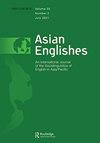编辑
IF 1.8
Q1 LINGUISTICS
引用次数: 1
摘要
最近,我对世界英语领域令人印象深刻的新生活力感到震惊。近几十年来,对英语变体的整体研究一直非常活跃,随着英语作为通用语言范式的发展,英语作为国际语言的新工作,以及被称为“全球英语”的新领域的出现,世界英语的出版物几乎达到了前所未有的水平。2015年,在新加坡国立教育学院系列编辑刘爱玲的指导下,《劳特利奇世界英语研究》系列开始推出。该系列在短短六年内已经出版了19卷。除了考察设得兰群岛、澳大利亚、非洲和新加坡等内圈和外圈背景外,它还包括越南、中国、韩国、日本和意大利的卷。它还包括以更区域性的方式(跨品种)考察品种的卷,例如东南亚国家联盟(东盟)以及东亚和南亚。出版的速度正在加快,每年出版三到四本书。第二个重要贡献是2021年出版的三卷本《布卢姆斯伯里世界英语》选集。朴茨茅斯大学的Mario Saraceni担任总编辑,第一卷《范式》由Britta Schneider和Theresa Heyd编辑;第二卷,《意识形态》,由拉尼·鲁迪和鲁阿尼·图帕斯编辑;第三卷,由Boğaziçi大学的Yasemin Bayyurt编辑的教育学。这些书有一个吸引人的黑色哑光饰面,封面上有蓝色,绿色或紫色的磷光字体,很容易区分这个系列。每卷有17篇文章,分为三个专题部分。其中包括一些引人入胜的新话题,如宾夕法尼亚州立大学的苏雷什·卡纳加拉加和加州大学欧文分校的杰里·李所著的《翻译主义和世界英语》。最后,或许也是最令人印象深刻的,是即将推出的《威利-布莱克威尔世界英语百科全书》项目,由金斯利·博尔顿担任主编。这部百科全书将在线出版,同时也有印刷版,由17卷组成,每卷都有自己的副编辑——都是该领域的主要学者。预计将有400个章节。百科全书还将为扩展圈英语找到一个家,包括中东和北非英语,欧洲英语以及中美洲和南美洲英语。这里的各种作品展示了世界英语范式的强大本质,以及它对在更复杂和令人兴奋的环境中使用英语的新的跨界领域和地区的承认和探索。也是《亚洲英语》2021年第23卷第1期。3, 227-228 https://doi.org/10.1080/13488678.2021.1983749本文章由计算机程序翻译,如有差异,请以英文原文为准。
EDITORIAL
I was struck recently with the impressive renewed vitality in the field of World Englishes. While the overall study of the variation in English has been highly active in recent decades, with the growth of the English as a lingua franca paradigm, renewed work in English as an international language, and the emergence of a newer field known as ‘Global Englishes’, publications in World Englishes are at an almost unprecedented level. A new series, Routledge Studies in World Englishes, started in 2015 under the guidance of series editor Ee Ling Low of the National Institute of Education, Singapore. The series has already produced 19 volumes in just six years. In addition to looking at Inner and Outer Circle contexts such as the Shetland Islands, Australia, Africa, and Singapore, it includes volumes on Vietnam, China, South Korea, Japan, and Italy. It also includes volumes which look at varieties in a more regional manner – across varieties – such as in the Association of Southeast Asian Nations (ASEAN), as well as East and South Asia. The pace of publication is increasing, with three or four books per year. A second significant contribution is the three-volume anthology Bloomsbury World Englishes, published in 2021. Mario Saraceni of Portsmouth University serves as overall editor, with volume 1, Paradigms edited by Britta Schneider and Theresa Heyd; volume 2, Ideologies edited by Rani Rubdy and Ruanni Tupas; and volume 3, Pedagogies edited by Yasemin Bayyurt of Boğaziçi University. The books have an attractive black matte finish, with blue, green, or purple phosphorescent typeface on the covers to easily distinguish the collection. Each volume has 17 contributions, separated into three thematic parts. These include fascinating new topics such as ‘Translingualism and World Englishes’, by Suresh Canagarajah (Pennsylvania State University) and Jerry Won Lee (University of California, Irvine). Finally, and perhaps most impressive, is the forthcoming Wiley-Blackwell Encyclopedia of World Englishes project, with Kingsley Bolton as chief editor. The encyclopedia will be online and also in print, comprising 17 separate volumes, each with its own sub-editor – all major scholars in the field. It is expected to have 400 chapters. The encyclopedia will also find a home for Expanding Circle Englishes, including volumes on Middle East and North African Englishes, European Englishes, and Central and South American Englishes. The various works here demonstrate the robust nature of the World Englishes paradigm, as well as its acknowledgment and exploration of new border-crossing domains and regions where English is used, in ever more complex and exciting contexts. It is also ASIAN ENGLISHES 2021, VOL. 23, NO. 3, 227–228 https://doi.org/10.1080/13488678.2021.1983749
求助全文
通过发布文献求助,成功后即可免费获取论文全文。
去求助
来源期刊

Asian Englishes
LINGUISTICS-
CiteScore
3.30
自引率
18.80%
发文量
34
期刊介绍:
Asian Englishes seeks to publish the best papers dealing with various issues involved in the diffusion of English and its diversification in Asia and the Pacific. It aims to promote better understanding of the nature of English and the role which it plays in the linguistic repertoire of those who live and work in Asia, both intra- and internationally, and in spoken and written form. The journal particularly highlights such themes as: 1.Varieties of English in Asia – Including their divergence & convergence (phonetics, phonology, prosody, vocabulary, syntax, semantics, pragmatics, discourse, rhetoric) 2.ELT and English proficiency testing vis-a-vis English variation and international use of English 3.English as a language of international and intercultural communication in Asia 4.English-language journalism, literature, and other media 5.Social roles and functions of English in Asian countries 6.Multicultural English and mutual intelligibility 7.Language policy and language planning 8.Impact of English on other Asian languages 9.English-knowing bi- and multilingualism 10.English-medium education 11.Relevance of new paradigms, such as English as a Lingua Franca, to Asian contexts. 12.The depth of penetration, use in various domains, and future direction of English in (the development of) Asian Societies.
 求助内容:
求助内容: 应助结果提醒方式:
应助结果提醒方式:


